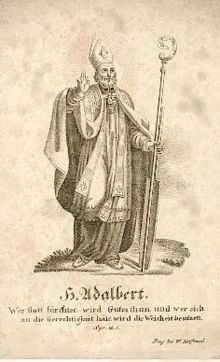Adalbert of Magdeburg
The holy Adalbert of Magdeburg (also: Albert , Adelbert , Adalbert I , Albertus I. , Adalbertus * to 910 in Lorraine , † 20 June 981 in Zscherben ) was the first Archbishop of Magdeburg , missionary and historian .
Live and act
Its origin is debatable. So it was assumed that he could have been a member of the older Babenbergs . This assumption is based on the guiding name principle . According to Theo Kölzer's thesis , who refers to a source from the Borghorst monastery , Adalbert should be identified as the brother of Berta , the foundress of the monastery , who was married to Bernhard von Sachsen.
Adalbert initially worked in the archbishop's office of Cologne and from 953 worked in the royal chancellery . From 958 to 961 he lived as a monk in the St. Maximin Monastery in Trier. In 961, on the recommendation of Archbishop Wilhelm von Mainz , an illegitimate son of Otto I , he was sent to the kingdom of the Kievan Rus with a Slavic princess in the function of a mission bishop . Unsuccessfully, however, only narrowly escaping death, he returned in 962. Despite this unsuccessful missionary trip, he was appointed abbot of the Weissenburg monastery by the emperor in early 966 and accompanied Otto II to Italy in 967 . In the years 966/967 Adalbert is said to have written a continuation of the world chronicle of Regino von Prüm for the years 907 to 967. This is considered to be the "only significant Ottonian annals of the 10th century". On December 24, 968, he was appointed archbishop of the newly formed archbishopric of Magdeburg by the emperor . He succeeded in expanding the Magdeburg Cathedral School into the education center of the empire and thus once again significantly increasing the importance of Magdeburg. As archbishop he continued to have close contact with the royal court. Adalbert received numerous documents from Otto I and Otto II. However, Adalbert did not stand out in imperial politics. The building of the archdiocese was probably his main activity.
From 972 to 981 St. Adalbert of Prague was trained under the direction of Priest Ohtrich at the Cathedral School in Magdeburg and received his name when he was confirmed by Archbishop Adalbert of Magdeburg. Ohtrich was a former student of Bishop Adalbert.
In 981 Adalbert died near Halle and did not experience the annihilation of the dioceses of Havelberg and Brandenburg in the Slav uprising of 983 . Adalbert's grave is located in Magdeburg Cathedral .
Canonization and Afterlife
Adalbert was later canonized. His Catholic feast day is June 20th. The St. Adalbert Church in Magdeburg, built from 1983 to 1985, is named after him.
Medieval studies showed little interest in the person of Adalbert and his work. Karl Hauck did not present a first fundamental investigation until 1974.
Work editions
- Adalberti Continuatio Reginonis. In: Sources for the history of the Saxon imperial era (= selected sources for the German history of the Middle Ages. Freiherr vom Stein-Gedächtnisausgabe. Vol. 8). Translated by Albert Bauer, Reinhold Rau. 5th edition, expanded by a supplement compared to the 4th, Darmstadt 2002, ISBN 3-534-01416-2 , pp. 190-231.
literature
- Dietrich Claude : Adalbert . In: Lexicon of the Middle Ages (LexMA). Volume 1, Artemis & Winkler, Munich / Zurich 1980, ISBN 3-7608-8901-8 , column 98 f.
- Karl Hauck: Archbishop Adalbert of Magdeburg as a historian. In: Helmut Beumann (Ed.) Festschrift for Walter Schlesinger. Vol. 2, Cologne 1974, pp. 276–353, ISBN 3-412-85074-8 .
- Joachim Leuschner : Adalbert I .. In: New German Biography (NDB). Volume 1, Duncker & Humblot, Berlin 1953, ISBN 3-428-00182-6 , p. 43 f. ( Digitized version ).
- Simon MacLean (Ed.): History and politics in late Carolingian and Ottonian Europe. The chronicle of Regino of Prüm and Adalbert of Magdeburg. Manchester 2009, ISBN 978-0-7190-7134-8 .
- Wolfgang Metz : Adalbert von Magdeburg and the necrologist . In: Archiv für Diplomatik Vol. 30 (1984), pp. 66–87.
- Wilhelm Wattenbach : Adelbert . In: Allgemeine Deutsche Biographie (ADB). Volume 1, Duncker & Humblot, Leipzig 1875, p. 62.
- Friedrich Wilhelm Bautz : ADALBERT I .. In: Biographisch-Bibliographisches Kirchenlexikon (BBKL). Volume 1, Bautz, Hamm 1975. 2nd, unchanged edition Hamm 1990, ISBN 3-88309-013-1 , Sp. 24-25.
Web links
- Albertus I or Adalbertus. In: Johann Heinrich Zedler : Large complete universal lexicon of all sciences and arts . Volume 1, Leipzig 1732, column 994.
- Literature by and about Adalbert von Magdeburg in the catalog of the German National Library
- Adalbert von Magdeburg in the Ecumenical Lexicon of Saints
- Biographical website
Remarks
- ↑ Herjo Frin: The origin Adalbert, the first archbishop of Magdeburg. In: Yearbook for Franconian State Research , Vol. 54 (1994), pp. 339-345, here: p. 344.
- ^ Theo Kölzer, Adalbert von St. Maximin, Archbishop of Magdeburg (968–981). In: Franz Josef Heyen (Ed.) Rheinische Lebensbilder. Issue 17, Cologne 1997, pp. 7-18.
- ↑ Biographies on German History from the Beginnings to 1945, Berlin 1991, p. 13.
- ^ Ernst Karpf: legitimation of rulers and the concept of the empire in Ottonian historiography of the 10th century. Stuttgart 1985, p. 47.
| predecessor | Office | successor |
|---|---|---|
| --- |
Archbishop of Magdeburg 968–981 |
Giselher |
| personal data | |
|---|---|
| SURNAME | Adalbert of Magdeburg |
| ALTERNATIVE NAMES | Albert of Magdeburg; Adelbert of Magdeburg; Adalbert I of Magdeburg; Albertus I of Magdeburg; Adalbertus of Magdeburg |
| BRIEF DESCRIPTION | German archbishop, saint and historian |
| DATE OF BIRTH | at 910 |
| PLACE OF BIRTH | Lorraine |
| DATE OF DEATH | June 20, 981 |
| Place of death | Shatter |
